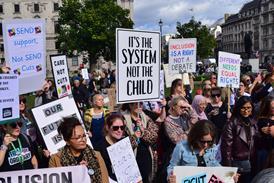Bankruptcy - the pensions saga
District Judge Neil Hickman with a guide on when a bankrupt's pension is now at the mercy of his creditors
When Parliament did something simple like restructuring the law of real property, all the legislation came into force on 1 January 1926.
Dealing with something difficult like pensions has so far required 12 commencement orders to bring various bits of the Welfare Reform & Pensions Act 1999 (WRPA) into force.
Commencement order 13 (SI 2002/153) adds another twist to pensions and insolvency.
For most people, the main worries about pensions are whether their policy is with Equitable Life and whether funds were invested in Enron shares.
Under the pre-1986 bankruptcy law, the trustee could apply to the court for a direction that part of a pension be made available for the creditors - ex parte Huggins (1882) 21 Ch D 85.
Pension falls into estate
Many people (apparently including the court in Kilvert v Flackett [1998] 2 FLR 806, [1998] Fam Law 582) assumed that under the Insolvency Act 1986, pension payments could be the subject of an income payments order but that the rights to the pension did not vest in the trustee.
The decision of Mr Justice Ferris in Re Landau [1998] Ch 223 was an unpleasant surprise.
He decided that:
l Rights under a personal pension policy formed part of the bankrupt's estate;
l Restrictions on alienation in the pension policy did not prevent this (apart from questions of public policy, vesting by operation of law was not an 'assignment'); and,
l Section 310 (dealing with income payments orders) had no application.
This meant that the whole of the pension of anybody who had been made bankrupt after 29 December 1986 (when the Insolvency Act came into force) vested in the trustee.
This applied even after discharge.
Landau was exhaustively considered by the Court of Appeal early in 2000 in Krasner v Dennison [2001] Ch 76, and upheld.
The obligatory invocation of the Human Rights Act, then on the horizon, also proved unavailing.
In Jones v Patel (2001) EWCA Civ 779, the Court of Appeal held that Landau could apply also to benefits under occupational pension schemes.
Mr Patel was made redundant by Brent Borough Council two months after being discharged from bankruptcy.
He retained his redundancy payment and notice pay, but the lump sum of 20,000, basic annual pension of 6,932 and enhanced pension rights all vested in his trustee.
However, the court applied ex parte James (1874) LR 9 Ch App 609 to say that the trustee could not retain the benefits attributable to Mr Patel's service, and contributions, after the bankruptcy.
Patel was slightly unusual - although the pension rights were expressed to be non-assignable, there was no forfeiture clause in the pension scheme.
While it is traditionally against public policy for an individual to contract for his property to be forfeited on bankruptcy this objection did not apply to a provision in an occupational pension scheme.
These clauses were upheld in re Scientific Instrument Pension Plan [1998] 2 FLR 761 with the result that no part of the pension went to the trustee.
Pension escapes estate
In Krasner v Dennison the House of Lords gave leave to appeal but Mr Dennison decided not to proceed.
The decision in the Court of Appeal on 6 April 2000 prompted the bringing into force of subsections (1) to (3) and (11) of section 11 of WRPA on 29 May 2000 by commencement order no 7.
Those subsections provide that where a person is made bankrupt on a petition presented after 29 May 2000, his rights under an approved pension arrangement are to be excluded from his estate.
'Approved' refers to Inland Revenue approval.
Section 11(1), incidentally, reads: 'Where a bankruptcy order is made...on a petition presented after the coming into force of this section...' The draftsman of the Act evidently did not anticipate that the section would come into force piecemeal on no fewer than three different dates - section 11(12) was implemented on 1 December 2000.
This year's changes see more sections of WRPA in force from 6 April 2002.
First comes the rest of section 11.
The commencement order summarises this as 'effect of bankruptcy on approved pension arrangements' but in fact subsections (4) to (10) deal with the failure of a scheme to secure approval or the withdrawal of a previous approval.
No surprises here - in those circumstances the benefits under the pension scheme vest in the trustee.
Although that relates back to the commencement of the bankruptcy (section 11(9)), the trustee cannot attack transactions made in good faith and without notice of the Inland Revenue's decision.
Unapproved scheme
That looks like bad news for the bankrupt, but to the (partial) rescue comes section 12 which allows yet more regulations, lurking in the Occupational and Personal Pension Schemes (Bankruptcy) Regulations 2002 (SI 2002/427), to permit rights under certain unapproved arrangements to be excluded from a bankrupt's estate.
The arrangement must be the bankrupt's sole or main pension (apart from any state pension).
The exclusion can be either by application to the court or by an agreement between the bankrupt and the trustee.
The regulations are complex and it is understood that minor amendments are in the pipeline.
If the bankrupt fails to act in time - he must apply for exclusion within 13 weeks from the estate or pension rights vesting in the trustee or within 30 days of a qualifying agreement being revoked - he loses his chance.
When will an order be made? The court will consider the future likely needs of the bankrupt and his family, and whether they will be adequately met by other pension rights which the bankrupt has - section 12(2)(b).
The section uses the words 'needs' and 'adequately' and this may mean a more stringent approach than is taken with income payments orders under section 310.
That section refers to 'reasonable domestic needs' and in re Rayatt [1998] BPIR 495 it was held that private education could be a reasonable domestic need.
Moreover, in Kilvert v Flackett, it was said that an income payments order did not necessarily have to reduce the defendant's income to that required for his family's reasonable domestic needs.
Over the top
So sections 11 and 12 are good news for the bankrupt but the balance is then redressed by section 15.
The trustee may seek an order in relation to rights under an approved arrangement or excluded rights under an unapproved arrangement.
If the court is satisfied that the rights are directly or indirectly the fruits of excessive contributions, it 'may make such order as it thinks fit for restoring the position to what it would have been had the excessive contributions not been made' - a familiar form of words.
When are contributions 'excessive'? The court will consider whether the making of them has unfairly prejudiced the creditors (section 15(2)(b)) and for that purpose will particularly take into account:
l Whether any of the contributions were made for the purpose of putting assets beyond the reach of the creditors or any of them; and,
l Whether the total amount of contributions is excessive in view of the individual's circumstances when they were made (section 15(6)).
There is no presumption to assist the trustee in proving a case under section 15(6)(a).
He will essentially have to prove an intention to defraud creditors and in my view the court must require convincing evidence before making such a finding.
Now that pensions are either excluded from the bankruptcy and available for the bankrupt, or available for the creditors, section 14 inserts a new section 159A in the Pension Schemes Act 1993 forbidding forfeiture on bankruptcy of rights under personal pension schemes.
The Pensions Act 1995 section 92(2) (which allowed forfeiture of rights under occupational pension schemes) ceases to apply.
District Judge Neil Hickman sits at Milton Keynes County Court


























No comments yet